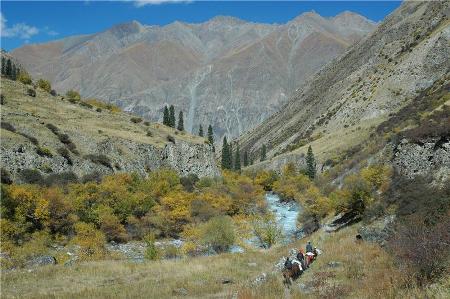Magma formation occurs when large amounts of liquids flow through the solid rocks as fluids. A research team headed by the University of Münster has demonstrated that the fluid flow through the rocks occurs at a much faster rate than earlier assumed.

The research team during the descent from the “Celestial Mountains” at an altitude of around 3,300 metres. (Copyright: Timm John, University of Münster)
The study results have been reported in the journal, Nature Geoscience. The study involved field work, numerical calculations and geochemical analysis. The scientist from Münster, Bochum, Lausanne (Switzerland), Bethlehem (USA), Erlangen and Kiel conducted the field work in the Chinese Tian Shan Mountains. Timm John from the University of Münster’s Institute for Mineralogy informed that the researchers discovered that the fluid flow occurred through a rock vein at a depth of around 70 km, meaning that the fluid might have apparently crossed several 100 m of distance. The researchers were the first to show the transportation of such huge amount of fluid flow that covered such a long distance. Moreover, the researchers found that the fluid flow occurred in just 200 years, a relatively short time in terms of geological processes, said Nikolaus Gussone from the Institute for Mineralogy.
The fluid release from minerals in the underneath plates is an ongoing large-scale process that occurs at depths of 200 km and requires millions of years. The fluids get accumulated during this time. The researchers demonstrated for the first time that the released fluids then ran through the plates in pulses along definite flow paths to reach the earth’s mantle in a comparatively less time. They plan to demonstrate the temporal and spatial connections between volcanic activity and such fluid pulses in future investigations. There may be a relation between such focused fluid releases and the event of earthquakes in subduction zones.
More research is required to show such relations. Petrologists from the Ruhr-Universitaet-Bochum simulated the chemical data to help the research team measure the time taken for the fluid to reach the mantle.
Disclaimer: The views expressed here are those of the author expressed in their private capacity and do not necessarily represent the views of AZoM.com Limited T/A AZoNetwork the owner and operator of this website. This disclaimer forms part of the Terms and conditions of use of this website.